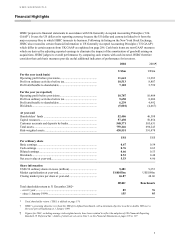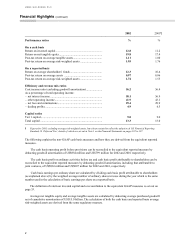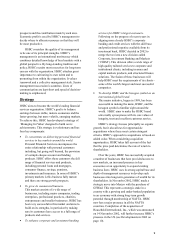HSBC 2002 Annual Report Download - page 10
Download and view the complete annual report
Please find page 10 of the 2002 HSBC annual report below. You can navigate through the pages in the report by either clicking on the pages listed below, or by using the keyword search tool below to find specific information within the annual report.-
 1
1 -
 2
2 -
 3
3 -
 4
4 -
 5
5 -
 6
6 -
 7
7 -
 8
8 -
 9
9 -
 10
10 -
 11
11 -
 12
12 -
 13
13 -
 14
14 -
 15
15 -
 16
16 -
 17
17 -
 18
18 -
 19
19 -
 20
20 -
 21
21 -
 22
22 -
 23
23 -
 24
24 -
 25
25 -
 26
26 -
 27
27 -
 28
28 -
 29
29 -
 30
30 -
 31
31 -
 32
32 -
 33
33 -
 34
34 -
 35
35 -
 36
36 -
 37
37 -
 38
38 -
 39
39 -
 40
40 -
 41
41 -
 42
42 -
 43
43 -
 44
44 -
 45
45 -
 46
46 -
 47
47 -
 48
48 -
 49
49 -
 50
50 -
 51
51 -
 52
52 -
 53
53 -
 54
54 -
 55
55 -
 56
56 -
 57
57 -
 58
58 -
 59
59 -
 60
60 -
 61
61 -
 62
62 -
 63
63 -
 64
64 -
 65
65 -
 66
66 -
 67
67 -
 68
68 -
 69
69 -
 70
70 -
 71
71 -
 72
72 -
 73
73 -
 74
74 -
 75
75 -
 76
76 -
 77
77 -
 78
78 -
 79
79 -
 80
80 -
 81
81 -
 82
82 -
 83
83 -
 84
84 -
 85
85 -
 86
86 -
 87
87 -
 88
88 -
 89
89 -
 90
90 -
 91
91 -
 92
92 -
 93
93 -
 94
94 -
 95
95 -
 96
96 -
 97
97 -
 98
98 -
 99
99 -
 100
100 -
 101
101 -
 102
102 -
 103
103 -
 104
104 -
 105
105 -
 106
106 -
 107
107 -
 108
108 -
 109
109 -
 110
110 -
 111
111 -
 112
112 -
 113
113 -
 114
114 -
 115
115 -
 116
116 -
 117
117 -
 118
118 -
 119
119 -
 120
120 -
 121
121 -
 122
122 -
 123
123 -
 124
124 -
 125
125 -
 126
126 -
 127
127 -
 128
128 -
 129
129 -
 130
130 -
 131
131 -
 132
132 -
 133
133 -
 134
134 -
 135
135 -
 136
136 -
 137
137 -
 138
138 -
 139
139 -
 140
140 -
 141
141 -
 142
142 -
 143
143 -
 144
144 -
 145
145 -
 146
146 -
 147
147 -
 148
148 -
 149
149 -
 150
150 -
 151
151 -
 152
152 -
 153
153 -
 154
154 -
 155
155 -
 156
156 -
 157
157 -
 158
158 -
 159
159 -
 160
160 -
 161
161 -
 162
162 -
 163
163 -
 164
164 -
 165
165 -
 166
166 -
 167
167 -
 168
168 -
 169
169 -
 170
170 -
 171
171 -
 172
172 -
 173
173 -
 174
174 -
 175
175 -
 176
176 -
 177
177 -
 178
178 -
 179
179 -
 180
180 -
 181
181 -
 182
182 -
 183
183 -
 184
184 -
 185
185 -
 186
186 -
 187
187 -
 188
188 -
 189
189 -
 190
190 -
 191
191 -
 192
192 -
 193
193 -
 194
194 -
 195
195 -
 196
196 -
 197
197 -
 198
198 -
 199
199 -
 200
200 -
 201
201 -
 202
202 -
 203
203 -
 204
204 -
 205
205 -
 206
206 -
 207
207 -
 208
208 -
 209
209 -
 210
210 -
 211
211 -
 212
212 -
 213
213 -
 214
214 -
 215
215 -
 216
216 -
 217
217 -
 218
218 -
 219
219 -
 220
220 -
 221
221 -
 222
222 -
 223
223 -
 224
224 -
 225
225 -
 226
226 -
 227
227 -
 228
228 -
 229
229 -
 230
230 -
 231
231 -
 232
232 -
 233
233 -
 234
234 -
 235
235 -
 236
236 -
 237
237 -
 238
238 -
 239
239 -
 240
240 -
 241
241 -
 242
242 -
 243
243 -
 244
244 -
 245
245 -
 246
246 -
 247
247 -
 248
248 -
 249
249 -
 250
250 -
 251
251 -
 252
252 -
 253
253 -
 254
254 -
 255
255 -
 256
256 -
 257
257 -
 258
258 -
 259
259 -
 260
260 -
 261
261 -
 262
262 -
 263
263 -
 264
264 -
 265
265 -
 266
266 -
 267
267 -
 268
268 -
 269
269 -
 270
270 -
 271
271 -
 272
272 -
 273
273 -
 274
274 -
 275
275 -
 276
276 -
 277
277 -
 278
278 -
 279
279 -
 280
280 -
 281
281 -
 282
282 -
 283
283 -
 284
284 -
 285
285 -
 286
286 -
 287
287 -
 288
288 -
 289
289 -
 290
290 -
 291
291 -
 292
292 -
 293
293 -
 294
294 -
 295
295 -
 296
296 -
 297
297 -
 298
298 -
 299
299 -
 300
300 -
 301
301 -
 302
302 -
 303
303 -
 304
304 -
 305
305 -
 306
306 -
 307
307 -
 308
308 -
 309
309 -
 310
310 -
 311
311 -
 312
312 -
 313
313 -
 314
314 -
 315
315 -
 316
316 -
 317
317 -
 318
318 -
 319
319 -
 320
320 -
 321
321 -
 322
322 -
 323
323 -
 324
324 -
 325
325 -
 326
326 -
 327
327 -
 328
328 -
 329
329
 |
 |

HSBC HOLDINGS PLC
Description of Business
8
Introduction
HSBC is one of the largest banking and financial
services organisations in the world, with a market
capitalisation of US$105 billion at 31 December
2002. At the end of 2002, HSBC had total assets of
US$759 billion and shareholders’ equity of US$52
billion. For the year ended 31 December 2002,
HSBC’s operating profit was US$9 billion on
revenues of US$27 billion. HSBC is a strongly
capitalised banking group with a total capital ratio of
13.3 per cent and a tier 1 capital ratio of 9.0 per cent
as at 31 December 2002.
Headquartered in London, HSBC operates
through long-established businesses in five regions:
Europe; Hong Kong; the rest of Asia-Pacific,
including the Middle East and Africa; North
America; and South America. Within each of these
geographical regions, the principal businesses
operate essentially as domestic banks and typically
have a large retail deposit base, together with strong
liquidity and capital ratios, and provide services to
personal, commercial and large corporate and
institutional customers. By using HSBC’s extensive
technological links, businesses are able to access its
wide range of products and services and adapt them
to local customer needs. In addition, in certain key
locations - London, Hong Kong, New York, Geneva,
Paris and Düsseldorf - HSBC has significant
investment and/or private banking operations which,
together with its commercial banks, enable HSBC to
service the requirements of its high net worth
personal, corporate and institutional customers.
Through its international network of over 8,000
offices in 80 countries and territories, HSBC
provides a comprehensive range of financial services
to personal, commercial, corporate, institutional and
investment, and private banking clients. The
establishment of HSBC as a uniform, international
brand has ensured that the Group’s corporate symbol
has become an increasingly familiar sight across the
world. HSBC’s largest and best-known subsidiaries
and their primary areas of operation are:
• The Hongkong and
Shanghai Banking
Corporation Limited
(‘The Hongkong and
Shanghai Banking
Corporation’ )
Hong Kong SAR, with
an extensive network
throughout Asia-
Pacific.
• Hang Seng Bank
Limited (‘Hang Seng
Bank’ )
Hong Kong SAR
• HSBC Bank plc United Kingdom
• CCF S.A. (‘CCF’ ) France
• HSBC Bank USA New York State in the
United States
• HSBC Bank Brasil
S.A.-Banco Múltiplo
(‘HSBC Bank
Brasil’ )
Brazil
• HSBC Private
Banking Holdings
(Suisse) S.A.
(‘HSBC Private
Banking Holdings’ )
Switzerland, Hong
Kong SAR, Monaco,
Luxembourg, United
Kingdom, Singapore
and the Channel
Islands.
• Grupo Financiero
Bital S.A. de C.V.
(‘GFBital’ )
Mexico
Management and resources
HSBC recognises that the substantial customer and
asset base of its banking operations reflects years of
trust and goodwill. Through its many years of
operation, HSBC has developed a reputation for
placing great value on long-term relationships with
its clients and on observing the principles of sound
and conservative banking. HSBC organises and
delivers its banking products and services in a way
that aims to retain local authority while capitalising
on the advantages that flow from being an
international organisation.
HSBC believes that this combination of
centralisation and local responsibility permits it to
remain responsive to local needs while providing
customers with access to the services and strength of
a worldwide financial institution.
HSBC allocates resources, including capital,
management time, human resources and information
technology, according to a range of factors, such as
size and complexity of the operation, growth
